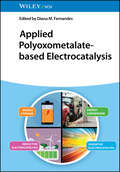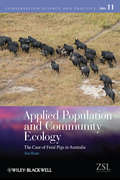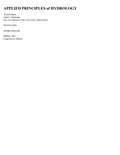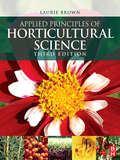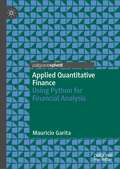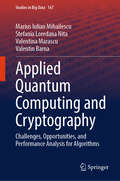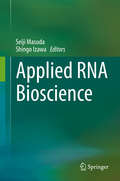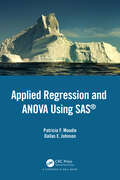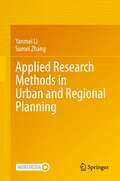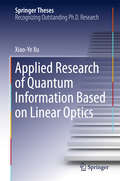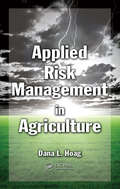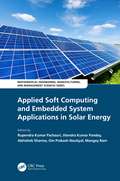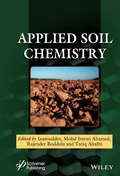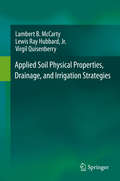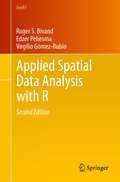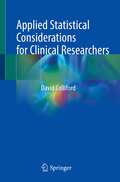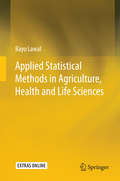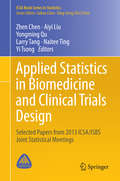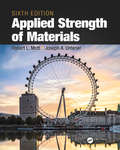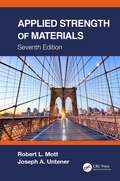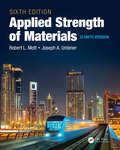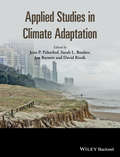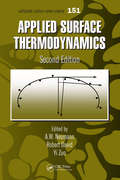- Table View
- List View
Applied Polyoxometalate-Based Electrocatalysis
by Diana M. FernandesWell-researched reference on stable alternative electrocatalysts and electrode materials with the potential to transform chemistry and processes in sensor- and energy-related technologies Applied Polyoxometalate-based Electrocatalysis delivers an overview of the variety of efficient applications of free POM and POM-based (nano)composites as exciting materials in the field of electrocatalysis. With a variety of sizes, shapes, composition, and physical and chemical properties, these composites have important properties, such as the ability to undergo reversible multivalence reductions/oxidations, leading to the formation of mixed-valence species, which brings about favorable electrocatalytic properties with regard to several electrochemical processes. Edited by a highly qualified independent researcher internationally recognized for her contributions to materials for electrochemical energy-related reactions, Applied Polyoxometalate-based Electrocatalysis includes information on: General methodologies used in the preparation of free POMs and POM-based nanocomposites and different strategies employed in electrode modification Role of POM-modified electrodes in oxidative and reductive electrocatalysis, including the detection/sensing of several (bio)molecules of interest and carbon dioxide electroreduction Application of POM-based (nano)composites, including the oxygen reduction reaction relevant to fuel cells, the oxygen and hydrogen evolution reactions, and batteries and supercapacitors Applied Polyoxometalate-based Electrocatalysis is an essential reference on the subject for chemists, material scientists, chemical engineers, and institutions involved in work related to free POM and POM-based (nano)composites.
Applied Population and Community Ecology: The Case of Feral Pigs in Australia (Conservation Science and Practice)
by Jim HonePart of the Zoological Society of London's Conservation Science and Practice Series, Applied Population and Community Ecology evaluates theory in population and community ecology using a case study of feral pigs, birds and plants in the high country of south-eastern Australia. In sequence, the book reviews the relevant theory and uses long-term research over a quarter of a century on the population ecology of feral pigs and then community ecology of birds and plants, to evaluate the theory. The book brings together into one volume, research results of many observational, experimental and modelling studies and directly compares them with those from related studies around the world. The implications of the results for future wildlife management are also discussed. Intended readers are ecologists, graduate students in ecology and wildlife management and conservation and pest managers.
Applied Principles Of Hydrology
by John C. ManningLess than 1% of the Earth's water is available for human use, the average family uses 400 gallons of water daily, and expected population growth means an increase in water use. The study of hydrology how water behaves as it moves through the water cycle is vital to reducing strains on our water supply and infrastructure.
Applied Principles of Horticultural Science
by Laurie BrownApplied Principles of Horticultural Science is that critical thing for all students of horticulture - a book that teaches the theory of horticultural science through the practice of horticulture itelf.The book is divided into three sections - Plant science, Soil science, Pest and disease. Each section contains a number of chapters relating to a major principle of applied horticulture. Each chapter starts with a key point summary and introduces the underpinning knowledge which is then reinforced by exercises. The book contains over 70 practical exercises, presented in a way that makes students think for themselves. Answers to the exercises are given at the end of chapters. Clear step-by-step instructions make practical work accessible to students of all abilities.This new third edition provides an even wider sweep of case studies to make this book an essential practical workbook for horticulture students and gardners alike. Updated material fits with the latest RHS, City and Guilds and Edexcel syllabus. It is particularly suitable for the RHS Certificate, Advanced Certificate and Edexcel Diplomas as well as for those undertaking NPTC National, Advanced National courses and Horticulture NVQs at levels 2 and 3, together with the new Diploma in Environmental and Land-based studies.Laurie Brown is a horticultural scientist and educator. He is Director of Academex, a consultancy company aspiring to excellence in teaching and learning. Laurie previously worked with the Standards Unit on the design of exemplary teaching resources in the land-based sector.
Applied Quantitative Finance: Using Python for Financial Analysis
by Mauricio GaritaThis book provides both conceptual knowledge of quantitative finance and a hands-on approach to using Python. It begins with a description of concepts prior to the application of Python with the purpose of understanding how to compute and interpret results. This book offers practical applications in the field of finance concerning Python, a language that is more and more relevant in the financial arena due to big data. This will lead to a better understanding of finance as it gives a descriptive process for students, academics and practitioners.
Applied Quantum Computing and Cryptography: Challenges, Opportunities, and Performance Analysis for Algorithms (Studies in Big Data #167)
by Stefania Loredana Nita Marius Iulian Mihailescu Valentina Marascu Valentin BarnaThis book explores the dynamically developing areas of quantum computing and quantum cryptography. The book offers an in-depth examination of the possibilities and difficulties presented by these revolutionary technologies, with the goal of connecting abstract ideas with real-world applications. The book is an extremely helpful resource in the context of the upcoming quantum age. This highlights the importance of creating cryptographic techniques that can withstand the power of quantum computers to protect digital communications and vital infrastructures. This work makes a substantial contribution to the topic of cybersecurity by doing a comprehensive analysis of classical and quantum cryptography approaches, as well as actual implementations and performance evaluations. The book plays a vital role in providing valuable guidance to researchers, practitioners, and policymakers. It offers valuable insights that are necessary for effectively managing the shift towards quantum-secure technology and safeguarding the future security of digital information.
Applied RNA Bioscience
by Seiji Masuda Shingo IzawaThe focus of this book is to introduce up-to-date information on applications and practical use of RNA for agriculture, biotechnology and medicine.<P><P> It provides unique ideas, tools, and methods in detail from a variety of scientific and technical disciplines. RNA science has progressed enormously in recent decades, and vast amounts of information on RNA functions and their regulatory mechanisms are becoming available. Such a progress opened the door to an age of practical application of RNA in many fields including agriculture, plant science, medical science, brewing and fermentation technology, and material production. <P>This book inspires its readership and contributes to not only expansion in application of RNA but also to basic research.
Applied Regression and ANOVA Using SAS
by Dallas E. Johnson Patricia F. MoodieApplied Regression and ANOVA Using SAS® has been written specifically for non-statisticians and applied statisticians who are primarily interested in what their data are revealing. Interpretation of results are key throughout this intermediate-level applied statistics book. The authors introduce each method by discussing its characteristic features, reasons for its use, and its underlying assumptions. They then guide readers in applying each method by suggesting a step-by-step approach while providing annotated SAS programs to implement these steps.Those unfamiliar with SAS software will find this book helpful as SAS programming basics are covered in the first chapter. Subsequent chapters give programming details on a need-to-know basis. Experienced as well as entry-level SAS users will find the book useful in applying linear regression and ANOVA methods, as explanations of SAS statements and options chosen for specific methods are provided.Features:•Statistical concepts presented in words without matrix algebra and calculus•Numerous SAS programs, including examples which require minimum programming effort to produce high resolution publication-ready graphics•Practical advice on interpreting results in light of relatively recent views on threshold p-values, multiple testing, simultaneous confidence intervals, confounding adjustment, bootstrapping, and predictor variable selection•Suggestions of alternative approaches when a method’s ideal inference conditions are unreasonable for one’s dataThis book is invaluable for non-statisticians and applied statisticians who analyze and interpret real-world data. It could be used in a graduate level course for non-statistical disciplines as well as in an applied undergraduate course in statistics or biostatistics.
Applied Research Methods in Urban and Regional Planning
by Yanmei Li Sumei ZhangThis book introduces the fundamentals of research methods and how they apply to the discipline of urban and regional planning. Written at a level appropriate for upper-level undergraduate and beginning master’s level students, the text fills a gap in the literature for textbooks on urban planning. Additionally, the book can be used as a reference for planning practitioners and researchers when analyzing quantitative and qualitative data in urban and regional planning and related fields.The volume does not assume advanced knowledge of mathematical formulas. Rather, it begins with the essentials of research methods, such as the identification of the research problems in planning, the literature review, data collection and presentation, descriptive data analysis, and report of findings. Its discipline-specific topics include field research methods, qualitative data analysis, economic and demographic analysis, evaluation research, and methods in sub-disciplines such as land use planning, transportation planning, environmental planning, and housing analysis. Designed with instruction in mind, this book features downloadable materials, including learning outcomes, chapter highlights, chapter review questions, datasets, and certain Excel models. Students will be able to download review questions to enhance the learning process and datasets to practice methods.
Applied Research of Quantum Information Based on Linear Optics (Springer Theses)
by Xiao-Ye XuThis thesis reports on outstanding work in two main subfields of quantum information science: one involves the quantum measurement problem, and the other concerns quantum simulation. The thesis proposes using a polarization-based displaced Sagnac-type interferometer to achieve partial collapse measurement and its reversal, and presents the first experimental verification of the nonlocality of the partial collapse measurement and its reversal. All of the experiments are carried out in the linear optical system, one of the earliest experimental systems to employ quantum communication and quantum information processing. The thesis argues that quantum measurement can yield quantum entanglement recovery, which is demonstrated by using the frequency freedom to simulate the environment. Based on the weak measurement theory, the author proposes that white light can be used to precisely estimate phase, and effectively demonstrates that the imaginary part of the weak value can be introduced by means of weak measurement evolution. Lastly, a nine-order polarization-based displaced Sagnac-type interferometer employing bulk optics is constructed to perform quantum simulation of the Landau-Zener evolution, and by tuning the system Hamiltonian, the first experiment to research the Kibble-Zurek mechanism in non-equilibrium kinetics processes is carried out in the linear optical system.
Applied Risk Management in Agriculture
by Dana L. HoagDefining the fundamentals of building a risk management plan, Applied Risk Management in Agriculture uses strategic management to organize the process of risk management. A time-tested procedure inside and outside the business community, this technique provides an ideal platform for organizing risk.Making complex principles easily accessible to stu
Applied Second Law Analysis of Heat Engine Cycles
by S. Can GülenApplied Second Law Analysis of Heat Engine Cycles offers a concise, practical approach to one of the two building blocks of classical thermodynamics and demonstrates how it can be a powerful tool in the analysis of heat engine cycles. Including real system models with the industry-standard heat balance simulation software, the Thermoflow Suite (GTPRO/MASTER, PEACE, THERMOFLEX) and Excel VBA, the book discusses both the performance and the cost. It also features both calculated and actual examples for gas turbines, steam turbines, and simple and combined cycles from major original equipment manufacturers (OEMs). In addition, novel cycles proposed by researchers and independent technology developers will also be critically examined. This book will be a valuable reference for practicing engineers, enabling the reader to approach the most difficult thermal design and analysis problems in a logical manner.
Applied Soft Computing and Embedded System Applications in Solar Energy (Mathematical Engineering, Manufacturing, and Management Sciences)
by Mangey Ram Jitendra Kumar Pandey Abhishek Sharma Om Prakash Nautiyal Rupendra Kumar PachauriApplied Soft Computing and Embedded System Applications in Solar Energy deals with energy systems and soft computing methods from a wide range of approaches and application perspectives. The authors examine how embedded system applications can deal with the smart monitoring and controlling of stand-alone and grid-connected solar photovoltaic (PV) systems for increased efficiency. Growth in the area of artificial intelligence with embedded system applications has led to a new era in computing, impacting almost all fields of science and engineering. Soft computing methods implemented to energy-related problems regularly face data-driven issues such as problems of optimization, classification, clustering, or prediction. The authors offer real-time implementation of soft computing and embedded system in the area of solar energy to address the issues with microgrid and smart grid projects (both renewable and non-renewable generations), energy management, and power regulation. They also discuss and examine alternative solutions for energy capacity assessment, energy efficiency systems design, as well as other specific smart grid energy system applications. The book is intended for students, professionals, and researchers in electrical and computer engineering fields, working on renewable energy resources, microgrids, and smart grid projects. Examines the integration of hardware with stand-alone PV panels and real-time monitoring of factors affecting the efficiency of the PV panels Offers real-time implementation of soft computing and embedded system in the area of solar energy Discusses how soft computing plays a huge role in the prediction of efficiency of stand-alone and grid-connected solar PV systems Discusses how embedded system applications with smart monitoring can control and enhance the efficiency of stand-alone and grid-connected solar PV systems Explores swarm intelligence techniques for solar PV parameter estimation Dr. Rupendra Kumar Pachauri is Assistant Professor – Selection Grade in the Department of Electrical and Electronics Engineering, University of Petroleum and Energy Studies (UPES), Dehradun, India. Dr. Jitendra Kumar Pandey is Professor & Head of R&D in the University of Petroleum and Energy Studies (UPES), Dehradun, India. Mr. Abhishek Sharma is working as a research scientist in the research and development department (UPES, India). Dr. Om Prakash Nautiyal is working as a scientist in Uttarakhand Science Education & Research Centre (USERC), Department of Information and Science Technology, Govt. of Uttarakhand, Dehradun, India. Prof. Mangey Ram is working as a Research Professor at Graphic Era Deemed to be University, Dehradun, India.
Applied Soil Chemistry
by Inamuddin Mohd Imran Ahamed Rajender Boddula Tariq AltalhiThis book explores the state-of-the-art information regarding applied soil sciences. It covers the fundamentals, model concepts, principles, chemical reactions, functions, chemical recycling, chemical weathering, acid-base chemistry, carbon sequestration, and nutrient availability of soils. Also, it includes soil chemistry of heavy-metals, environment, clay, ion-exchange processes, analytical tools and applications. This book helps to understand the about soil characteristics targeting soil chemical reactions and interactions and its applications.
Applied Soil Physical Properties, Drainage, and Irrigation Strategies.
by Lambert B. Mccarty Lewis Ray Hubbard Jr. Virgil QuisenberryThe book is a realistic blend of basic knowledge and understanding in soil physical properties. It will enable the reader to scientifically analyze soils to develop practical and successful means of providing sufficient drainage and to develop science-based irrigation strategies. Only basic mathematical knowledge is necessary to understand and apply the proven principles covered. With limited resources that are increasing significantly in costs, the book blends the ideal concept of providing sufficient drainage and irrigation based on using soil physical properties but with financial limitations in mind. One traditional problem with many Soil Physics, Drainage, and Irrigations-based texts is the prerequisite of understanding complicated calculus-based mathematics. Although necessary for a theory-based text, our text was developed with practitioners in mind where such complicated mathematics was avoided but referenced if the reader wishes to further explore the specific topic. Another problem with many traditional texts is the lack of practical examples or case-studies allowing readers to relate their specific scenarios to similar types of situations. We have purposely included numerous examples and practical field experiences. This is especially true when many of the theoretical ideals are covered, followed by explanations of how such ideals can be applied in the laboratory and field.
Applied Spatial Data Analysis with R (Use R! #10)
by Virgilio Gómez-Rubio Roger S. Bivand Edzer PebesmaApplied Spatial Data Analysis with R, second edition, is divided into two basic parts, the first presenting R packages, functions, classes and methods for handling spatial data. This part is of interest to users who need to access and visualise spatial data. Data import and export for many file formats for spatial data are covered in detail, as is the interface between R and the open source GRASS GIS and the handling of spatio-temporal data. The second part showcases more specialised kinds of spatial data analysis, including spatial point pattern analysis, interpolation and geostatistics, areal data analysis and disease mapping. The coverage of methods of spatial data analysis ranges from standard techniques to new developments, and the examples used are largely taken from the spatial statistics literature. All the examples can be run using R contributed packages available from the CRAN website, with code and additional data sets from the book's own website. Compared to the first edition, the second edition covers the more systematic approach towards handling spatial data in R, as well as a number of important and widely used CRAN packages that have appeared since the first edition. This book will be of interest to researchers who intend to use R to handle, visualise, and analyse spatial data. It will also be of interest to spatial data analysts who do not use R, but who are interested in practical aspects of implementing software for spatial data analysis. It is a suitable companion book for introductory spatial statistics courses and for applied methods courses in a wide range of subjects using spatial data, including human and physical geography, geographical information science and geoinformatics, the environmental sciences, ecology, public health and disease control, economics, public administration and political science. The book has a website where complete code examples, data sets, and other support material may be found: http://www.asdar-book.org. The authors have taken part in writing and maintaining software for spatial data handling and analysis with R in concert since 2003.
Applied Statistical Considerations for Clinical Researchers
by David CullifordThis essential book details intermediate-level statistical methods and frameworks for the clinician and medical researcher with an elementary grasp of health statistics and focuses on selecting the appropriate statistical method for many scenarios. Detailed evaluation of various methodologies familiarizes readers with the available techniques and equips them with the tools to select the best from a range of options. The inclusion of a hypothetical case study between a clinician and statistician charting the conception of the research idea through to results dissemination enables the reader to understand how to apply the concepts covered into their day-to-day clinical practice.Applied Statistical Considerations for Clinical Researchers focuses on how clinicians can approach statistical issues when confronted with a medical research problem by considering the data structure, how this relates to their study's aims and any potential knock-on effects relating to the evidence required to make correct clinical decisions. It covers the application of intermediate-level techniques in health statistics making it an ideal resource for the clinician seeking an up-to-date resource on the topic.
Applied Statistical Methods in Agriculture, Health and Life Sciences
by Bayo LawalThis textbook teaches crucial statistical methods to answer research questions using a unique range of statistical software programs, including MINITAB and R. This textbook is developed for undergraduate students in agriculture, nursing, biology and biomedical research. Graduate students will also find it to be a useful way to refresh their statistics skills and to reference software options. The unique combination of examples is approached using MINITAB and R for their individual strengths. Subjects covered include among others data description, probability distributions, experimental design, regression analysis, randomized design and biological assay. Unlike other biostatistics textbooks, this text also includes outliers, influential observations in regression and an introduction to survival analysis. Material is taken from the author's extensive teaching and research in Africa, USA and the UK. Sample problems, references and electronic supplementary material accompany each chapter.
Applied Statistics in Biomedicine and Clinical Trials Design: Selected Papers from 2013 ICSA/ISBS Joint Statistical Meetings (ICSA Book Series in Statistics)
by Zhen Chen Aiyi Liu Yongming Qu Larry Tang Naitee Ting Yi TsongThis volume is a unique combination of papers that cover critical topics in biostatistics from academic, government, and industry perspectives. The 6 sections cover Bayesian methods in biomedical research; Diagnostic medicine and classification; Innovative Clinical Trials Design; Modelling and Data Analysis; Personalized Medicine; and Statistical Genomics. The real world applications are in clinical trials, diagnostic medicine and genetics. The peer-reviewed contributions were solicited and selected from some 400 presentations at the annual meeting of the International Chinese Statistical Association (ICSA), held with the International Society for Biopharmaceutical Statistics (ISBS). The conference was held in Bethesda in June 2013, and the material has been subsequently edited and expanded to cover the most recent developments.
Applied Stochastic Control of Jump Diffusions (Universitext)
by Bernt Øksendal Agnès SulemHere is a rigorous introduction to the most important and useful solution methods of various types of stochastic control problems for jump diffusions and its applications. Discussion includes the dynamic programming method and the maximum principle method, and their relationship. The text emphasises real-world applications, primarily in finance. Results are illustrated by examples, with end-of-chapter exercises including complete solutions. The 2nd edition adds a chapter on optimal control of stochastic partial differential equations driven by Lévy processes, and a new section on optimal stopping with delayed information. Basic knowledge of stochastic analysis, measure theory and partial differential equations is assumed.
Applied Strength of Materials
by Joseph A. Untener Robert MottDesigned for a first course in strength of materials, Applied Strength of Materials has long been the bestseller for Engineering Technology programs because of its comprehensive coverage, and its emphasis on sound fundamentals, applications, and problem-solving techniques. The combination of clear and consistent problem-solving techniques, numerous end-of-chapter problems, and the integration of both analysis and design approaches to strength of materials principles prepares students for subsequent courses and professional practice. The fully updated Sixth Edition. Built around an educational philosophy that stresses active learning, consistent reinforcement of key concepts, and a strong visual component, Applied Strength of Materials, Sixth Edition continues to offer the readers the most thorough and understandable approach to mechanics of materials.
Applied Strength of Materials
by Robert L. Mott Joseph A. UntenerThis text is an established bestseller in engineering technology programs, and the Seventh Edition of Applied Strength of Materials continues to provide comprehensive coverage of the mechanics of materials. Focusing on active learning and consistently reinforcing key concepts, the book is designed to aid students in their first course on the strength of materials. Introducing the theoretical background of the subject, with a strong visual component, the book equips readers with problem-solving techniques. The updated Seventh Edition incorporates new technologies with a strong pedagogical approach. Emphasizing realistic engineering applications for the analysis and design of structural members, mechanical devices, and systems, the book includes such topics as torsional deformation, shearing stresses in beams, pressure vessels, and design properties of materials. A "big picture" overview is included at the beginning of each chapter, and step-by-step problem-solving approaches are used throughout the book. FEATURES Includes "the big picture" introductions that map out chapter coverage and provide a clear context for readers Contains everyday examples to provide context for students of all levels Offers examples from civil, mechanical, and other branches of engineering technology Integrates analysis and design approaches for strength of materials, backed up by real engineering examples Examines the latest tools, techniques, and examples in applied engineering mechanics This book will be of interest to students in the field of engineering technology and materials engineering as an accessible and understandable introduction to a complex field.
Applied Strength of Materials, Sixth Edition SI Units Version
by Robert L. Mott Joseph A. UntenerAPPLIED STRENGTH OF MATERIALS 6/e, SI Units Version provides coverage of basic strength of materials for students in Engineering Technology (4-yr and 2-yr) and uses only SI units. Emphasizing applications, problem solving, design of structural members, mechanical devices and systems, the book has been updated to include coverage of the latest tools, trends, and techniques. Color graphics support visual learning, and illustrate concepts and applications. Numerous instructor resources are offered, including a Solutions Manual, PowerPoint slides, Figure Slides of book figures, and extra problems. With SI units used exclusively, this text is ideal for all Technology programs outside the USA.
Applied Studies in Climate Adaptation
by Sarah L. Boulter Jon Barnett Jean P. Palutikof David RissikThe book advances knowledge about climate change adaptation practices through a series of case studies. It presents important evidence about adaptation practices in agriculture, businesses, the coastal zone, community services, disaster management, ecosystems, indigneous populations, and settlements and infrastructure. In addition to 38 case studies across these sectors, the book contains horizon-scoping essays from international experts in adaptation research, including Hallie Eakin, Susanne Moser, Jonathon Overpeck, Bill Solecki, and Gary Yohe.Australia's social-ecological systems have a long history of adapting to climate variability and change, and in recent decades has been a world-leader in implementing and researching adaptation, making this book of universal relevance to all those working to adapt our environment and societies to climate change.
Applied Surface Thermodynamics (Surfactant Science)
by Robert David A. Wilhelm Neumann Yi ZuoSurface thermodynamics forms the foundation of any meaningful study of capillarity and wetting phenomena. The second edition of Applied Surface Thermodynamics offers a comprehensive state-of-the-art treatment of this critical topic. It provides students and researchers with fundamental knowledge and practical guidelines in solving real-world proble
